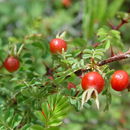Description
provided by eFloras
Shrubs 3–5 m tall. Branchlets terete, glabrous or sparsely puberulous, prickly; prickles paired below leaves, sometimes scattered, straight or slightly curved, to 1.5 cm, stout, flat, gradually tapering to broad base, sometimes intermixed with smaller prickles and bristles, old branches sometimes intermixed with bristles. Leaves including petiole 6–11 cm; stipules mostly adnate to petiole, free parts ovate-lanceolate, margin glandular serrate, apex acuminate; rachis and petiole pubescent, glandular-pubescent, sparsely shortly prickly; leaflets 7–11, elliptic or ovate-oblong, 2–5 × 0.8–2 cm, abaxially pubescent or glandular, with prominent midvein and lateral veins, adaxially glabrous, base subrounded or broadly cuneate, margin doubly serrate, apex acute, rarely rounded-obtuse. Flowers solitary, or 2 or 3 and fasciculate, 3–5 cm in diam.; pedicel 1.5–3 cm; bracts 1 or 2, ovate-lanceolate, abaxially with distinct midvein, margin glandular serrate, sometimes pinnately lobed, apex caudate. Hypanthium oblong or obovoid, often stipitate glandular. Sepals 5, ovate-lanceolate, leaflike, abaxially subglabrous, stipitate glandular or not, adaxially puberulous, margin sometimes pinnately lobed. Petals 5, pink, broadly obovate, base broadly cuneate, apex emarginate. Styles free, much shorter than stamens, densely pubescent. Hip purple-red, oblong or obovoid-oblong, 1.5–2.5 × 1–1.7 cm, with a short neck at apex, often glandular hirsute, with persistent, erect sepals. Fl. Jun–Jul, fr. Aug–Nov.
- license
- cc-by-nc-sa-3.0
- copyright
- Missouri Botanical Garden, 4344 Shaw Boulevard, St. Louis, MO, 63110 USA
Distribution
provided by eFloras
Gansu, Hubei, Qinghai, Shaanxi, Sichuan, Xizang, Yunnan.
- license
- cc-by-nc-sa-3.0
- copyright
- Missouri Botanical Garden, 4344 Shaw Boulevard, St. Louis, MO, 63110 USA
Habitat
provided by eFloras
Pinus forest margins, scrub, roadsides; 2300--3800 m.
- license
- cc-by-nc-sa-3.0
- copyright
- Missouri Botanical Garden, 4344 Shaw Boulevard, St. Louis, MO, 63110 USA
Cyclicity
provided by Plants of Tibet
Flowering from June to July; fruiting from August to November.
Diagnostic Description
provided by Plants of Tibet
Rosa sweginzowii var. sweginzowii is close relative of Rosa sweginzowii var. glandulosa, but differs from the latter in its leaflets abaxially pubescent or only along veins pubescent, not glandular (vs. with dense stalked glands), pedicel 1.5-2 cm (vs. 2-3 cm), glandular- pubescent (vs. densely pubescent).
Distribution
provided by Plants of Tibet
Rosa sweginzowii is occurring in Gansu, Hubei, Qinghai, Shaanxi, Sichuan, Xizang, Yunnan of China.
Evolution
provided by Plants of Tibet
Phylogenetic analyses of Rosa were inferred from non-coding chloroplast sequences trnL-F region and psbA-trnH (Bruneau et al., 2007). Bayesian and parsimony analyses suggest that subgenus Rosa can be divided into two large clades. One comprises species from sections Carolinae, Cinnamomeae and Pimpinellifoliae p.p., whilst the other consists of all of the remaining sections of subgenus Rosa (Banksianae p.p., Bracteatae, Caninae, Indicae, Laevigatae, Rosa, Synstylae and Pimpinellifoliae p.p.). A fairly complete sampling of field-collected North American taxa has been incorporated in this analysis. Analyses indicate that migration into North America occurred at least twice within this primarily Old World genus. Most North American taxa, except R. setigera and R. minutifolia, fall into a single clade that includes Asian and European taxa. Analyses also are consistent with the notion that cultivated commercial roses have a relatively narrow genetic background. Six of the seven primary taxa believed to be involved in the creation of domesticated roses are found within the same large clade that mostly includes Asian and European taxa.
General Description
provided by Plants of Tibet
Shrubs 3-5 m tall. Branchlets terete, glabrous or sparsely puberulous, prickly; prickles paired below leaves, sometimes scattered, straight or slightly curved, to 1.5 cm, stout, flat, gradually tapering to broad base, sometimes intermixed with smaller prickles and bristles, old branches sometimes intermixed with bristles. Leaves including petiole 6-11 cm; stipules mostly adnate to petiole, free parts ovate-lanceolate, margin glandular serrate, apex acuminate; rachis and petiole pubescent, glandular-pubescent, sparsely shortly prickly; leaflets 7-11, elliptic or ovate-oblong, 2-5 cm long, 0.8-2 cm wide, abaxially pubescent or only along veins pubescent, not glandular, with prominent midvein and lateral veins, adaxially glabrous, base subrounded or broadly cuneate, margin doubly serrate, apex acute, rarely rounded-obtuse. Flowers solitary, or 2 or 3 and fasciculate, 3-5 cm in diameter; pedicel 1.5-2 cm, glandular-pubescent; bracts 1 or 2, ovate-lanceolate, abaxially with distinct midvein, margin glandular serrate, sometimes pinnately lobed, apex caudate. Hypanthium oblong or obovoid, often stipitate glandular. Sepals 5, ovate-lanceolate, leaflike, abaxially subglabrous, stipitate glandular or not, adaxially puberulous, margin sometimes pinnately lobed. Petals 5, pink, broadly obovate, base broadly cuneate, apex emarginate. Styles free, much shorter than stamens, densely pubescent. Hip purple-red, oblong or obovoid-oblong, 1.5-2.5 cm long, 1-1.7 cm wide, with a short neck at apex, often glandular hirsute, with persistent, erect sepals.
Habitat
provided by Plants of Tibet
Growing in scrub, roadsides; 2300-3600 m.

